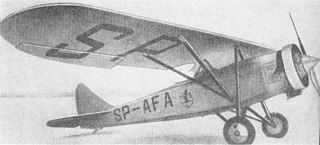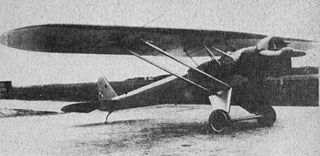
The PZL-Mielec M-18 Dromader is a single engine agricultural aircraft that is manufactured by PZL-Mielec in Poland. The aircraft is used mainly as a cropduster or firefighting machine.

The PZL-101 Gawron (rook) is a Polish agricultural and utility aircraft designed and built by WSK-Okęcie.

PZL M-4 Tarpan was a Polish trainer and sports aircraft prototype of the 1960s, designed in WSK-Mielec.

The PZL.44 Wicher (gale) was a prototype of 14-seat, twin-engine Polish airliner, built in the Państwowe Zakłady Lotnicze (PZL) in 1938. It was to compete with the DC-2 and Lockheed Super Electra.

The LWD Żak was a Polish touring and trainer aircraft of the late 1940s, designed in the LWD and built in a short series.

PZL.26 was a Polish sports plane built in 1934 in the PZL works. Ordered by the Ministry of Defence, it was specifically designed for the upcoming Challenge 1934 International Touring Aircraft Contest.
The PZL M-24 Dromader Super is a single engine agricultural aircraft, developed in the 1980s by the WSK-Mielec from the PZL-Mielec M-18 Dromader. It did not progress beyond the prototyping stage.

The PZL-105 Flaming (flamingo) is a Polish short-takeoff-and-landing (STOL) utility aircraft designed by PZL "Warszawa-Okęcie". It remained a prototype.

The PZL-5 was a Polish two-seat touring and sports aircraft of 1930 constructed and produced by the PZL.

The PZL Ł.2 was a Polish Army cooperation and liaison aircraft, built in 1929 in the Polskie Zakłady Lotnicze (PZL) in Warsaw. Only a small series of 31 aircraft, including prototype, were made, and used by the Polish Air Force in the 1930s. The aircraft was known in Poland for accomplishing of a long-distance tour around Africa in 1931.

The PZL S-1 was a Polish trainer and liaison aircraft of 1945, which remained a prototype. It was the second aircraft built in Poland after World War II.

The PZL M-17 "Duduś Kudłacz" was a Polish twin-boom pusher general aviation and trainer aircraft of 1977, which remained a prototype.

PZL M-2 was a Polish trainer aircraft prototype of 1958, a low-wing monoplane with fixed gear. Designed at WSK-Mielec, it did not enter production.

The RWD 16bis and RWD 21 were Polish two-seat low-wing touring and sports planes of the late 1930s, constructed by the RWD bureau, sharing the same construction, main difference of the RWD 21 being a stronger engine.

The SZD-21 Kobuz was a single-seat aerobatic glider designed and built in Poland at Szybowcowy Zakład Doświadczalny in Bielsko-Biała from 1958.

The SZD-10 Czapla was a two-seat training glider aircraft that was designed and built in Poland from 1953.

The SZD-15 Sroka was a single-seat glider designed and built in Poland in 1956.

The SZD-18 Czajka was a single-seat glider designed and built in Poland in 1956.

The SZD-22 Mucha Standard was a single-seat aerobatic glider designed and built in Poland from 1957.

The IS-1 Sęp was a single-seat high-performance glider designed and built in Poland from 1947. It was the first post-war Polish glider.



















